Ridley’s Helium is the Belgian brand’s lightweight race bike, with the top-flight SLX piloted by pro team Lotto Dstny (formerly Lotto Soudal).
This model comes under the ‘Essential Series’ moniker, which Ridley claims has the same stiffness and ride quality characteristics as its top-tier sibling, but constructed from a more cost-effective grade of carbon fibre.
In testing, I’ve found the Helium Essential to be an excellent climber. That said, it’s not as accomplished when tipping down the other side and the bike is becoming outdated in some of its design and spec choices.
Ridley Helium Disc frame details
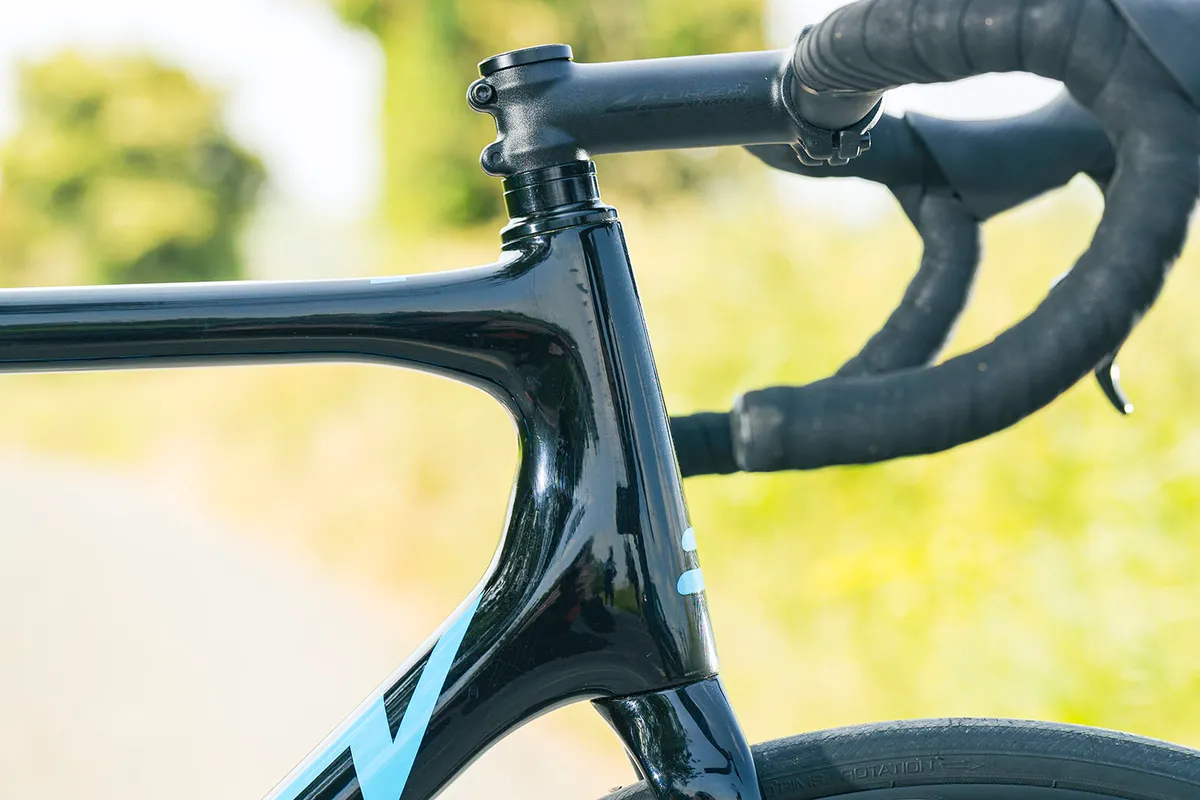
The Helium cuts a traditional silhouette and at first glance, and you might think it has classic round tubes. You’d be wrong, however – look closely and you’ll notice they’re all oval. Ridley says this design balances stiffness, comfort and weight.
The Essential frames use 24-30T high-modulus unidirectional Toray carbon compared to the lighter 50-60T recipe for the SLX.
Ridley claims an 825g frame weight in a size medium for an Essential frame, just 45g more than the SLX at 780g. The fork is claimed to weigh 355g.
The Helium features dropped seatstays, which Ridley says adds comfort and maximises power transfer. That aside, the thin seat tube will have a larger bearing on compliance because the stays push back on the over-flexing tube.
Many of the best climbing bikes have started to integrate aerodynamic features as brands have deduced the optimisations are worth the slight weight penalty. With the exception of the ovalised tube shapes and its integrated front end, the Helium largely eschews aerodynamics and is instead focused on weight.
The carbon fork features the brand’s F-steerer, which (alphabetical curiosity aside) means it is D-shaped so any cables and hoses can run in front of it.
There’s clearance for up to 28mm road bike tyres. That’s rather narrow by current standards, with BMC’s Teammachine accepting 30mm rubber and both the Cervélo R5 and Cannondale SuperSix Evo rated to 34mm.
Although the Trek Émonda is also officially rated to 28mm, the American brand is notably conservative on tyre clearance.
The bike uses a press-fit PF30 bottom bracket standard with a 68mm shell width. Of all the press-fit standards, PF30 is one of my preferred options, having good compatibility with most cranksets. I prefer it over BB30 because it does away with the need for circlips to retain the bearings.
Slightly more uncommon is the headset standard, which uses a conventional 1-1/8in upper bearing but a 1-1/4in lower bearing. Other brands, such as Canyon and Scott, also use this standard on some of their bikes.
The bike pleasingly uses a 27.2mm round seatpost with a traditional clamp – this means you’re not locked into a proprietary post, nor do you have to fiddle around with an awkwardly placed internal wedge clamp.
Ridley Helium Disc geometry
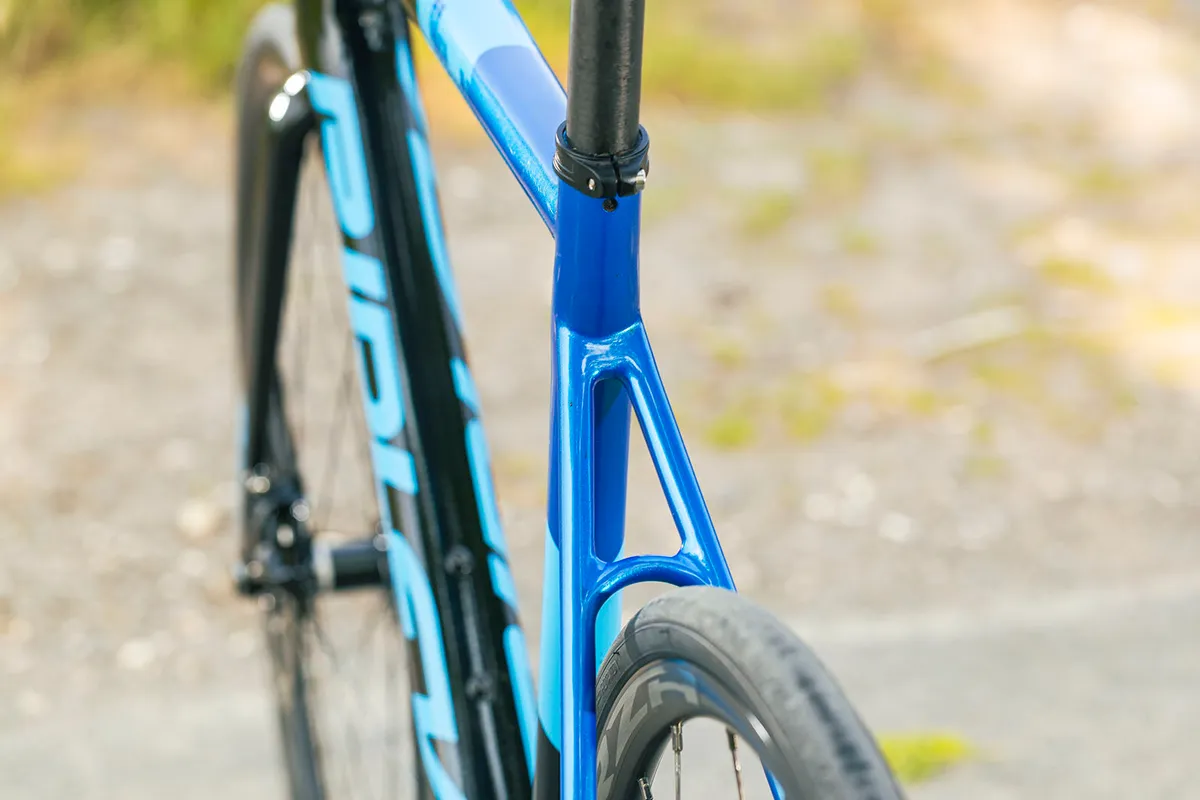
Ridley’s bike sizes run large, so while I would typically ride a large (or 56cm) frame for my 5ft 11 height, I opted for a medium. There are six sizes on offer (XXS through XL).
Rather than offering separate women-specific bikes, Ridley offers custom bike fitting and builds for women.
The Helium’s geometry is suitably racey and in some ways, old-school.
The frame has a 73.5-degree head tube angle and a 73-degree seat tube angle. For comparison, a Trek Émonda has a matching head angle with a slightly steeper 73.3-degree seat tube angle.
BMC’s Teammachine SLR01 has a matching seat tube angle, but a slacker 72.5-degree head angle.
The reach on a size medium is 390mm, with the stack higher than its competitors at 573mm.
The Émonda has a 391mm reach and lower 559mm stack, whereas the Teammachine SLR01 sports a 392mm reach and 560mm stack. Both the Émonda and Teammachine feature longer 410mm chainstays.
The chainstays are notably short at 405mm.
Longer chainstay lengths typically increase in stability, but the Helium’s wheelbase is longer than the Émonda's at 987mm compared to 983mm. Neither are a match for the 996mm wheelbase of the Teammachine.
There were a couple of foibles with the Helium’s fit. The 110mm stem was 10mm too long for me and I’d have also preferred a slightly steeper seat tube angle because I had to run the saddle slammed forward to achieve my optimum cleat position.
Ridley says the bike in this size is designed to be used with a 110mm stem.
A 100mm Forza stem wasn’t made available to swap onto the bike (more on this later), but Ridley says you can customise the bike’s fit at the point of purchase. Because production models use the Deda Superbox stem, making changes shouldn’t be too arduous.
| | XXS | XS | S | M | L | XL |
|---|---|---|---|---|---|---|
| Seat angle (degrees) | 75 | 74 | 73.5 | 73 | 72.5 | 72.5 |
| Head angle (degrees) | 71.8 | 72 | 73 | 73.5 | 73.5 | 74 |
| Chainstay (mm) | 405 | 405 | 405 | 405 | 408 | 408 |
| Seat tube (mm) | 450 | 480 | 510 | 540 | 570 | 600 |
| Top tube (mm) | 515 | 525 | 545 | 565 | 585 | 600 |
| Head tube (mm) | 110 | 130 | 145 | 175 | 205 | 230 |
| Bottom bracket drop (mm) | 68 | 68 | 66 | 66 | 63 | 63 |
| Wheelbase (mm) | 970 | 970 | 977 | 987 | 1,005 | 1,014 |
| Stack (mm) | 507 | 527 | 542 | 573 | 599 | 624 |
| Reach (mm) | 379 | 374 | 384 | 390 | 396 | 403 |
Ridley Helium Disc build
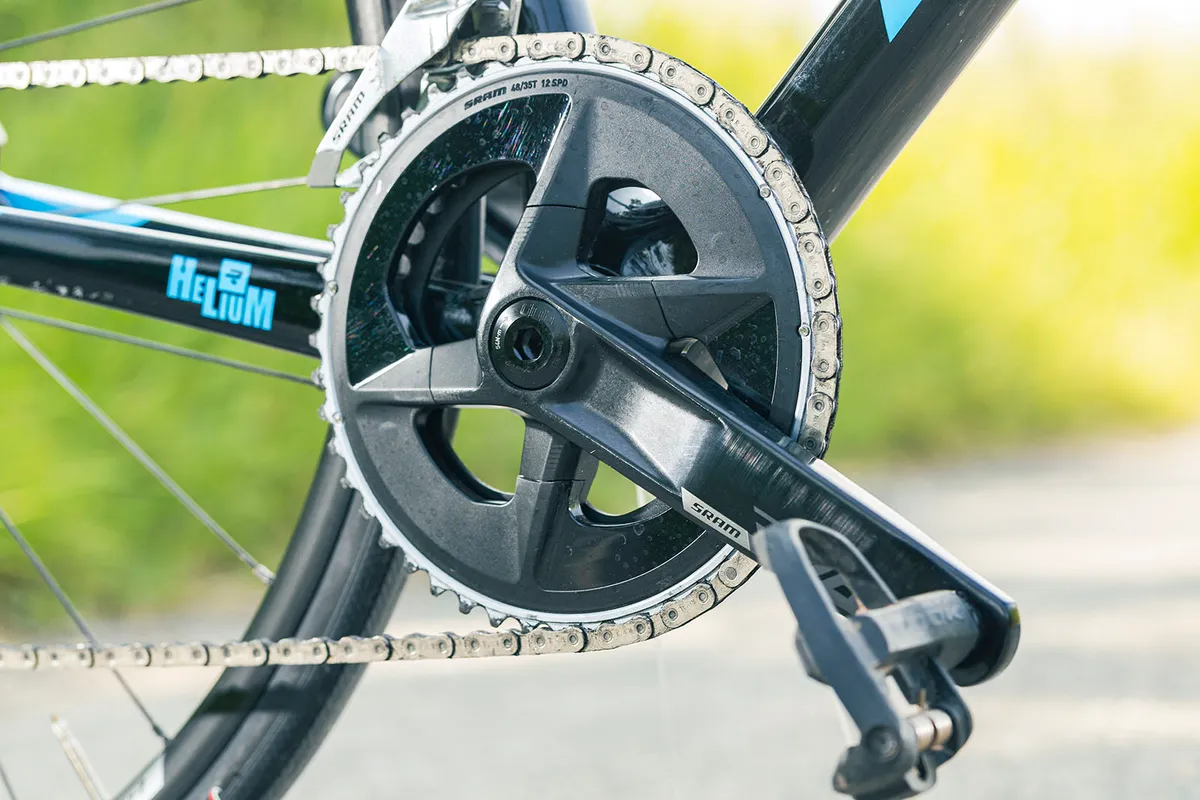
My test bike uses a handlebar and stem from Forza (Ridley’s in-house brand), which completely hides the hydraulic hoses and uses round headset spacers. This means you can’t adjust the handlebar height or run a different stem length without undoing the hydraulic hoses.
Fortunately, production models instead employ Deda’s Superbox system, which uses split headset spacers – a far simpler system if you want to make an adjustment.
Ridley says you can customise the handlebar width and stem length at purchase, and order replacements should your needs change.
My bike was specced with a 42cm handlebar – I prefer to ride 40cm-wide handlebars and the flattened hoods of the Forza bars were an odd shape, but you can customise this in the build.
This model is built up with full SRAM Rival eTap AXS. The third-tier electronic groupset from SRAM is found on a plethora of road bikes at this price point and offers generally sound performance.
Ridley specs its own Forza Norte aluminium rims on Forza Beaufort DB hubs. They feature a 20mm internal rim width and 23mm depth. I weighed them in at 1,664g (without disc lockrings, front 785g and rear 879g).
They’re paired with Vittoria Rubino Pro G2.0 tyres in a 25mm width.
If you stump up another £560, you can opt for Forza’s Levante carbon wheels instead, which sport a narrower 19mm internal rim width but are deeper at 38mm. Ridley pairs them with Vittoria Corsa G2.0 tyres, again in a 25mm width.
On the scales of truth, this medium-sized test bike weighs in at 8.12kg without pedals.
Ridley Helium Disc performance
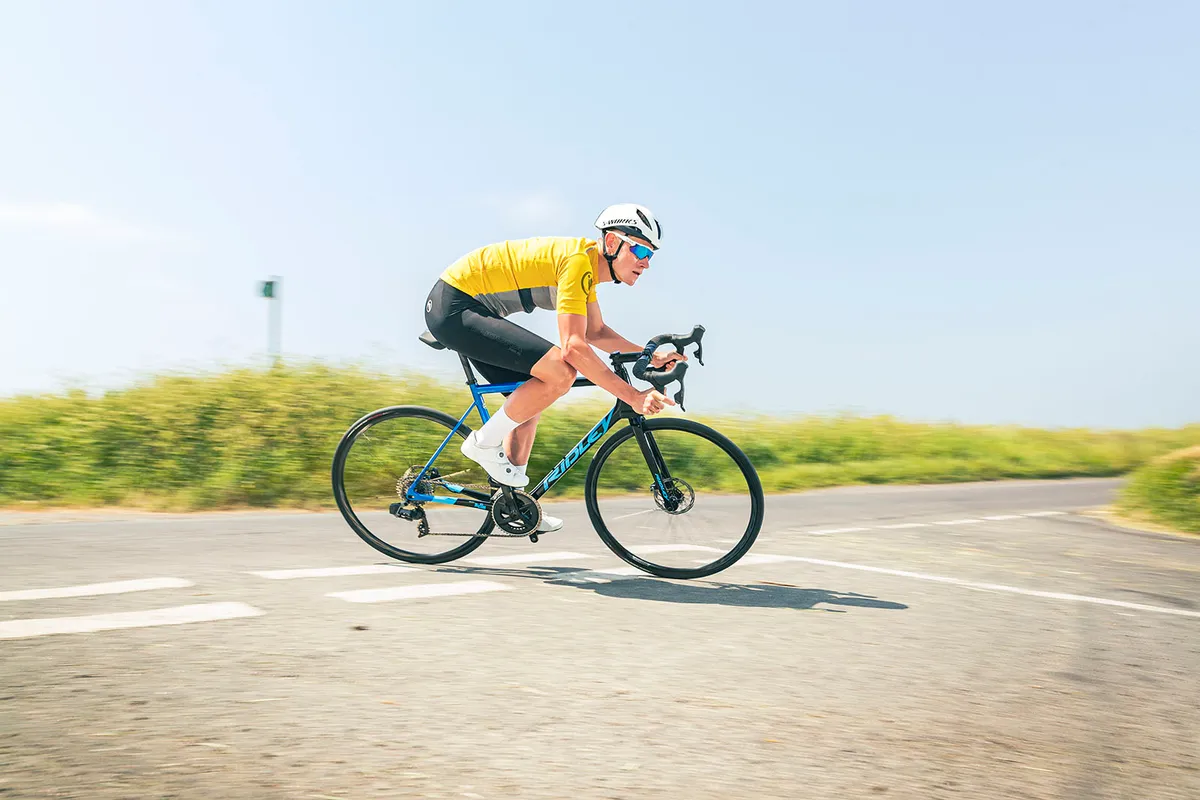
The Helium Essential took me quite a while to get used to – longer than most bikes I’ve tested. It wasn’t until 500km or so, across solo spins, Sunday club runs and weeknight chaingangs, that I found myself fully accustomed to the bike.
Despite the less exotic carbon layup, I couldn’t detect any flex at the bottom bracket area, and the bike felt taut and efficient.
I’d be reticent to label the Helium as offering a harsh ride, but there’s no denying it’s on the firmer side.
The stock 25mm Vittoria Rubino Pro tyres certainly don’t help the frame feel connected to the road.
It’s not the quickest to accelerate in a straight line, but it holds its momentum reasonably once up to speed.
Where the bike is in its element is when the gradients head up, which is especially interesting considering the slightly slacker seat tube angle.
I took the Helium up two of Simon Warren’s UK Top 100 climbs in testing – Combe Gibbet in West Berkshire and Weston Hill in Bath. While my legs complained, the bike impressed.
The Helium responds well to being thrown around side to side. That said, I didn’t reach the point of needing to stand out of the saddle until later in the climb compared to past experiences on other comparable bikes.
On undulating terrain, with short and steep rises and descents that never let you settle into a proper rhythm, the bike excelled and felt very efficient and responsive.
The Helium rides like a lighter bike than its 8.12kg weight (plus the usual accoutrements) would suggest, and it would be relatively easy to get the bike into the mid-7kg range with some smart upgrades.
The best climbing bikes balance exceptional uphill performance and offer a thrilling ride downhill too. Unfortunately, I found the Helium’s descending performance to be its Achilles heel.
It’s strangely nervous and doesn’t inspire confidence when gliding around corners, which is especially odd considering the 110mm stem should translate to slower steering.
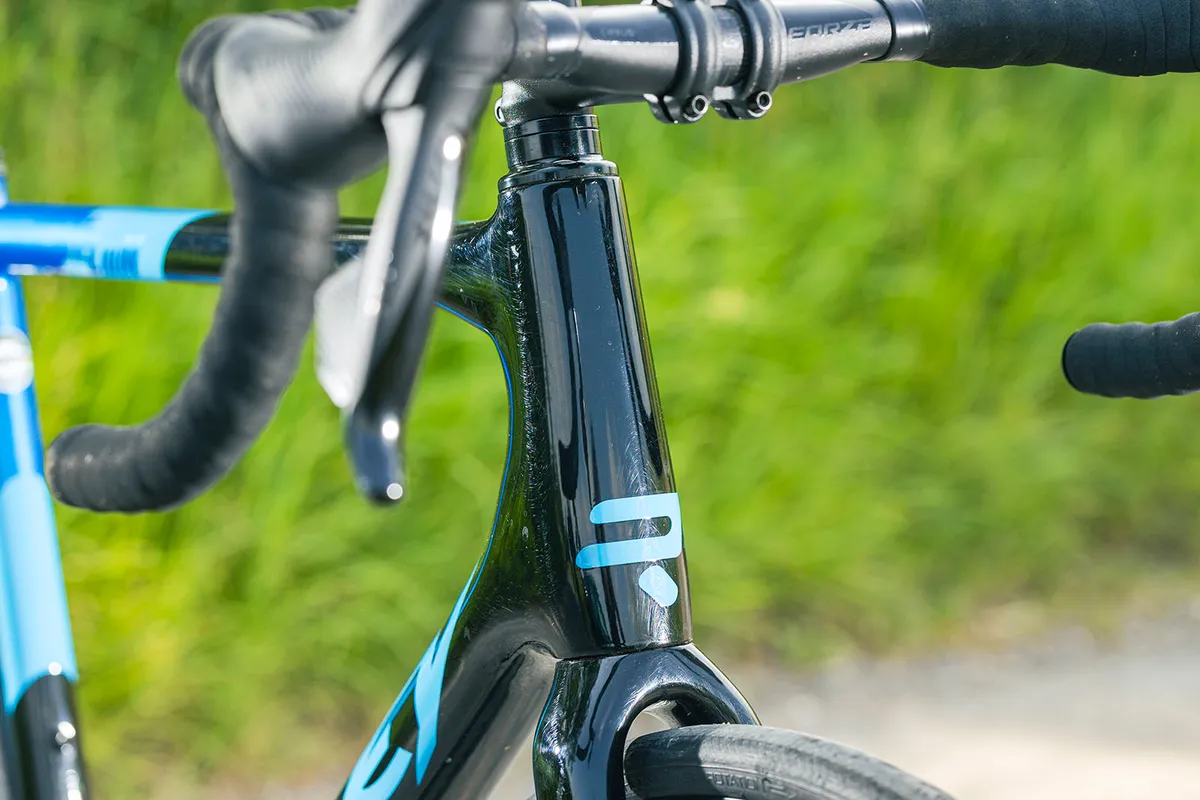
Ridley designed my medium test bike around a 110mm stem, but you’ll only speed up the handling if you need to run a shorter stem.
The Vittoria tyres don’t help, but even when I fitted a lighter Hunt Alloy SL wheelset and wider 28mm Pirelli Cinturato Velo tyres, I still had a distinctly disconnected sensation, like I was sitting on top of the bike rather than being part of it.
The short wheelbase and chainstays will play a role here, but the 45mm fork rake and 53mm trail likely have a great bearing over the bike’s descending performance.
Increased trail translates to slower handling at speed. The Trek Émonda sports a 40mm rake and 58mm trail, and the BMC Teammachine has a 43mm rake and 63mm trail.
With the Ridley featuring a significantly shorter trail measurement and larger rake, this increases the sharpness of the handling at speed.
The wheel and tyre combination is pretty unremarkable. The tyres offer a dull ride and are far from supple. I’m also unsure why Vittoria recommends a 100-130psi range for them – I rode a more sensible 80psi for my 73kg weight.
I found previous incarnations of this tyre to offer a dull ride and puncture easily, but I didn’t experience this here and they even resisted a chunky gravel track quite well. Perhaps that’s down to the newer graphene material infused into the tyre’s carcass.
I’d still recommend upgrading the tyres if you’re after a more supple and comfortable ride because it will make a significant difference.
Towards the end of testing, I swapped to my reference Hunt Alloy SL wheelset that weighs 1,410g with 28mm Pirelli Cinturato Velo tyres.
While it made for a slightly more lively and comfortable experience, the ride quality was still on the firmer side. The tyres bulged out to 31mm at 70psi, with little clearance remaining.
Ridley has got it spot-on with the 48/35-tooth chainrings (equivalent to a more conventional 52/36) and 172.5mm crank length on this size medium. The 10-36t cassette makes for a wide range when climbing, with the 36t a nice bail-out option.
Otherwise, there’s little to be said based on my previous experiences with the SRAM Rival eTap AXS groupset. The brakes are excellent, but I don’t get on with the smaller hood ergonomics and the front derailleur shifting speed isn’t on a par with Shimano.
I also suffered two chain drops towards the back end of testing.
Thumbs up also to Ridley for speccing cork black bar tape. It's cheap, easy to wrap and always performs well. The Cirrus carbon seatpost also damped vibrations well.
My test bike came with a Forza Stratos saddle, which I found unremarkable but didn’t see the need to swap it out in testing. Production models come with a Selle Italia XR.
Elsewhere, the paint scheme is striking and the gloss finish means scratches can be polished out to a degree, unlike matt.
The internal cable routing of the frame is surprisingly quiet and, with the exception of the saddle rails creaking occasionally on the seatpost, the bike was noise-free throughout testing.
Ridley Helium Disc bottom line
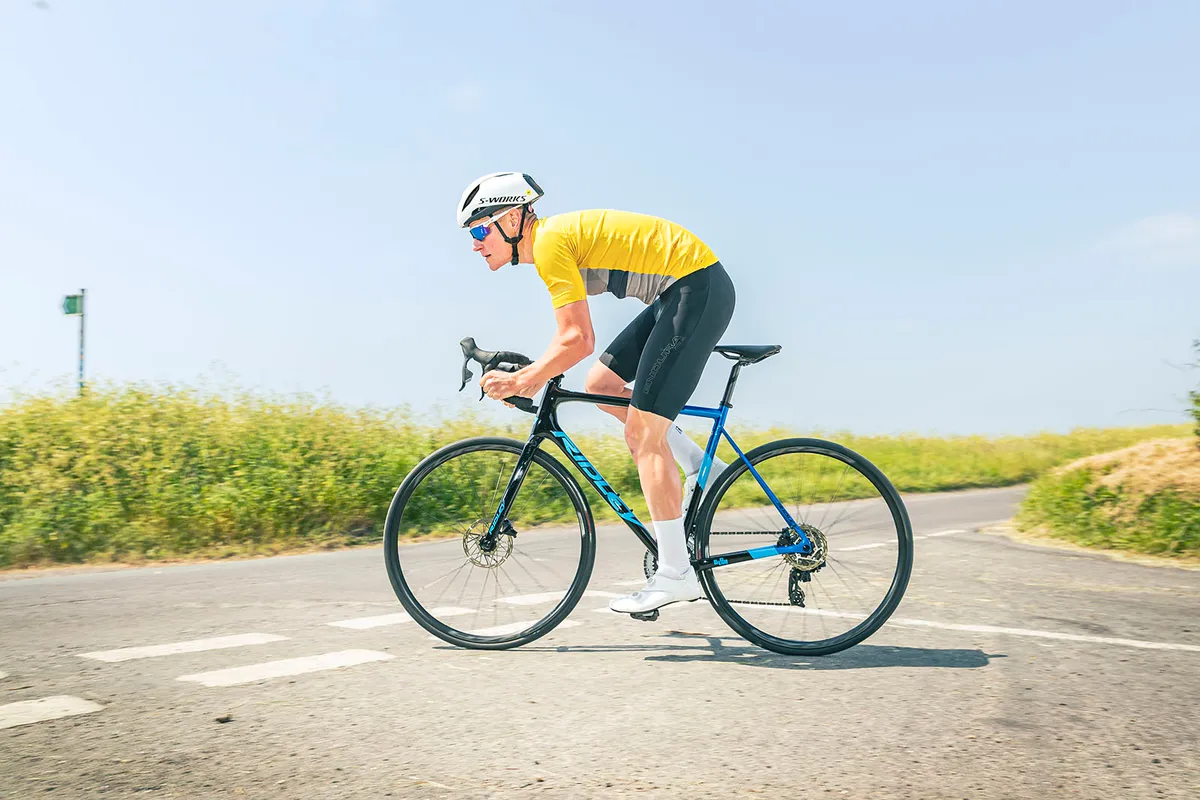
Although not quite the dreamy experience the bike’s geometry suggested it could have been, the Helium is a fine offering from the Belgian brand with a penchant for climbs.
However, in an increasingly crowded market, there’s little to propel it above its rivals. A more progressive geometry that lends itself more to descending and a more generous tyre clearance would be the key aspects to improve on in a future update.
If you’re in search of gradient-warning signs and extended mountain passes, the Helium would be a very solid option if you’re happy to compromise on the descents.
Product
| Brand | Ridley_bikes |
| Price | A$8299.00, €4399.00, £4400.00, $5499.00 |
| Weight | 8.12kg |
Features
| Fork | Helium Disc, 24-30T HM UD Carbon, F-Steerer |
| Stem | Deda Superbox (our test bike has come with a 4ZA aluminium stem) |
| Chain | SRAM Rival eTap AXS |
| Frame | Helium Disc, 24-30T HM UD Carbon, Stiffness-to-Weight optimised layup, F-Steerer |
| Tyres | Vittoria Rubino Pro G2.0, 700c x 25mm |
| Brakes | SRAM Rival eTap AXS |
| Cranks | SRAM Rival eTap AXS, 48/35t, 172.5mm |
| Saddle | Selle Italia XR (our test bike has come with a 4ZA Stratos) |
| Wheels | Forze Norte db rims on Forza 3 Beaufort hubs |
| Shifter | SRAM Rival eTap AXS, 12-speed |
| Cassette | SRAM XG1250, 10-36 |
| Seatpost | Forza Cirrus, carbon, 27.2mm |
| Handlebar | Deda Zero 2 (our test bike has come with a 4ZA aluminium bar) |
| Bottom bracket | PF30 |
| Available sizes | XXS, XS, S, M, L, XL |
| Rear derailleur | SRAM Rival eTap AXS |
| Front derailleur | SRAM Rival eTap AXS |
